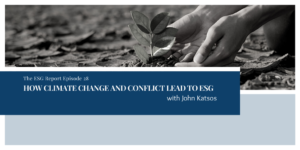
Tom Fox welcomes John Katsos to this episode of the ESG Report. John is an Associate Professor of Management at The American University of Sharjah, a scholar, and a writer. In this conversation, they talk about issues in conflict zones affected by climate change, migration, and corporate responses like ESG to these issues.
Migration Then and Now
“What’s changed is the scale, but what hasn’t changed is that environmental factors lead to migration,” John tells Tom. The rapid climate changes in this century also mean that more people are being affected. The adverse environmental factors also lead to social strife. John adds that people migrate not only for job availability, but also for food stability, and where the government is able to sustain them. This is only going to get worse in the future as the human population is so much larger than it was in the past. “We’re having to deal with lots of people from lots of places and the ability of countries to manage that is becoming more and more difficult,” John remarks.
A Fraction of The General Global Refugee Population
Tom asks John to share insight into what roles conflict, civil war, and rebellion play in migration. “The two main drivers of people to leave are political instability and violence on the one hand, and then environmental issues on the other hand,” John begins. In conflict zones, most people move around, but usually to neighboring countries. The wave of people migrating to Western countries is not a big fraction of the general global refugee population. “When people are impacted by conflict zones, we often see they’re not traveling far distances,” John tells Tom. When refugees travel far, it is usually because they have the money and wherewithal to do so.
The Potential for Exploitation
The risk of migration is that on one side some people are doing so legally, but on the other, others are using criminal networks and organizations to get them in or out of countries. These same criminal organizations are often exploiting people in other ways. The issue for business professionals with this is that very often, large corporations are not paying enough attention to how those organizations are utilizing their labor. “Companies have to be focused on making sure that they’re not using labor that’s being exploited,” John tells Tom. Another issue is that also, less reputable companies will use cheaper labor and not record it in their books.
Doing Ethical Business In a Conflict Zone
The two main questions business professionals must ask themselves when deciding to operate business in conflict zones are: why are you there, and do you want to be there. Companies need to think critically about this, and make sure that they’re not conducting business that is exploitative. “If you’re there to take something out as quickly and efficiently as possible and sell it somewhere else, you need to be really careful about where your funding is going, who you’re paying, who you’re employing, and how your operations are working next to or in concert with conflict actors,” John stresses. If companies decide that they need to be in these zones, and are providing jobs and necessities for the people there, it is more harmful for them to withdraw. However, each company will have to come to that decision themselves.
Resources
John Katsos | LinkedIn | Twitter





